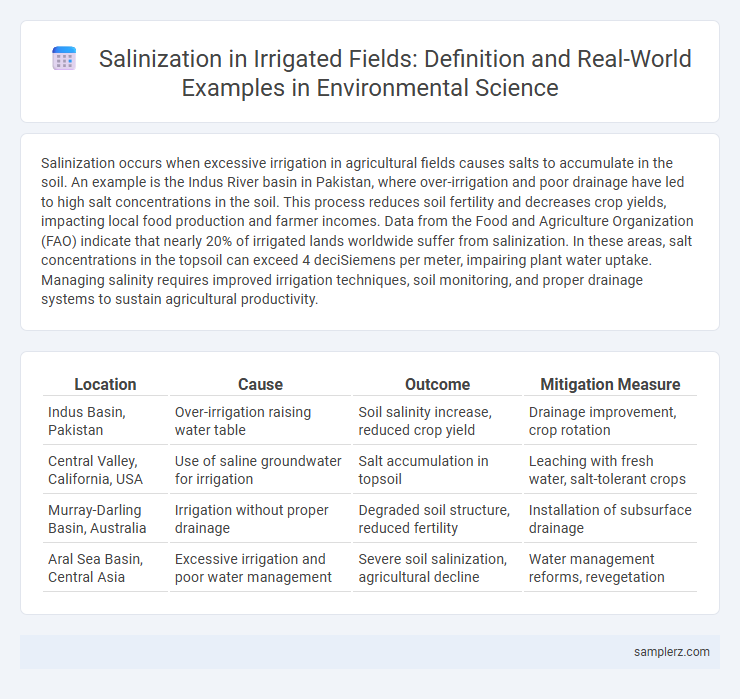Salinization occurs when excessive irrigation in agricultural fields causes salts to accumulate in the soil. An example is the Indus River basin in Pakistan, where over-irrigation and poor drainage have led to high salt concentrations in the soil. This process reduces soil fertility and decreases crop yields, impacting local food production and farmer incomes. Data from the Food and Agriculture Organization (FAO) indicate that nearly 20% of irrigated lands worldwide suffer from salinization. In these areas, salt concentrations in the topsoil can exceed 4 deciSiemens per meter, impairing plant water uptake. Managing salinity requires improved irrigation techniques, soil monitoring, and proper drainage systems to sustain agricultural productivity.
Table of Comparison
| Location | Cause | Outcome | Mitigation Measure |
|---|---|---|---|
| Indus Basin, Pakistan | Over-irrigation raising water table | Soil salinity increase, reduced crop yield | Drainage improvement, crop rotation |
| Central Valley, California, USA | Use of saline groundwater for irrigation | Salt accumulation in topsoil | Leaching with fresh water, salt-tolerant crops |
| Murray-Darling Basin, Australia | Irrigation without proper drainage | Degraded soil structure, reduced fertility | Installation of subsurface drainage |
| Aral Sea Basin, Central Asia | Excessive irrigation and poor water management | Severe soil salinization, agricultural decline | Water management reforms, revegetation |
Understanding Salinization in Irrigated Agriculture
Salinization in irrigated agriculture occurs when excessive evaporation leaves accumulated salts in the soil, reducing crop productivity and soil fertility. In regions like the Indus Valley, salt buildup has degraded millions of hectares of farmland, impacting food security and farmer livelihoods. Effective irrigation management and drainage systems are essential to prevent salt accumulation and maintain sustainable agricultural practices.
Causes of Salinity Buildup in Farmland
Irrigation with saline water and poor drainage are primary causes of salinity buildup in irrigated farmland, leading to the accumulation of salts in the soil profile. Excessive evaporation rates concentrate salts near the soil surface, while inadequate leaching fails to wash away these salts effectively. Over time, this salinization reduces soil fertility, adversely affecting crop yield and sustainability.
Real-World Example: Salinization in California’s Central Valley
California's Central Valley faces severe soil salinization due to prolonged irrigation combined with poor drainage, causing salt accumulation that reduces agricultural productivity. Extensive use of groundwater for irrigation introduces high levels of salts, especially sodium chloride, leading to decreased crop yields and increased soil degradation. Efforts to manage salinization in this region include improved irrigation practices and soil amendments to mitigate salt buildup and sustain agricultural viability.
Case Study: Punjab, India’s Irrigated Saline Soils
Punjab, India, faces severe salinization issues in its irrigated fields due to intensive groundwater irrigation and poor drainage systems, leading to soil salt accumulation that reduces agricultural productivity. Studies show that nearly 30% of Punjab's irrigated land suffers from mild to severe salinity, impacting staple crops like wheat and rice. Effective management practices include improved irrigation techniques, salt-tolerant crop varieties, and restoration of natural drainage to mitigate soil degradation in this vital agricultural region.
Impacts of Salinization on Crop Yield and Soil Health
Salinization in irrigated fields reduces crop yield by disrupting water uptake and causing ion toxicity, leading to stunted growth and lower biomass production. Soil health deteriorates as salt accumulation decreases microbial activity, soil structure stability, and nutrient availability, resulting in long-term fertility loss. Regions like California's Central Valley and parts of India's Punjab exemplify severe salinization impacts, threatening food security and sustainable agriculture.
Early Signs of Salinization in Irrigated Fields
Early signs of salinization in irrigated fields include the appearance of white crusty deposits on the soil surface and stunted crop growth due to salt accumulation. Soil electrical conductivity measurements exceeding 4 dS/m indicate increasing salinity levels that disrupt water uptake by plants. Monitoring soil texture changes and reduced microbial activity can help farmers detect and manage salinization before significant yield losses occur.
Monitoring and Measuring Soil Salinity Levels
Monitoring and measuring soil salinity levels in irrigated fields involve using electrical conductivity (EC) sensors and soil sampling to assess salt concentration accurately. Remote sensing technologies, such as satellite imagery and drones equipped with spectral sensors, help detect salinization patterns over large areas. Regular salinity assessments enable timely management interventions to prevent crop yield loss and maintain soil health.
Traditional Irrigation Practices Leading to Salinization
Traditional irrigation practices, such as flood irrigation and poor drainage systems, often cause soil salinization by raising the water table and allowing salts to accumulate on the soil surface. Fields irrigated with high-salinity water without proper leaching exacerbate salt buildup, reducing crop yields and soil fertility. The Indus Valley and parts of Central Asia illustrate how centuries-old irrigation methods have intensified salinization issues, threatening sustainable agriculture.
Modern Solutions for Salinity Management in Agriculture
Modern solutions for salinity management in irrigated fields include the use of salt-tolerant crop varieties and precise irrigation techniques such as drip irrigation that minimize salt accumulation in the root zone. Advanced soil amendments like gypsum and biochar improve soil structure and enhance salt leaching, reducing the impact of salinization on crop yield. Precision agriculture technologies incorporating soil salinity sensors and automated water management systems enable real-time monitoring and targeted interventions to maintain optimal soil health.
Sustainable Strategies to Prevent Salinization in Irrigated Areas
Implementing efficient irrigation techniques such as drip irrigation significantly reduces waterlogging and salt accumulation in soil, promoting sustainable agriculture. Crop rotation with salt-tolerant plants enhances soil structure and prevents salinity buildup in irrigated fields. Integrating proper drainage systems facilitates the removal of excess salts, maintaining soil health and long-term productivity.

example of salinization in irrigated field Infographic
 samplerz.com
samplerz.com